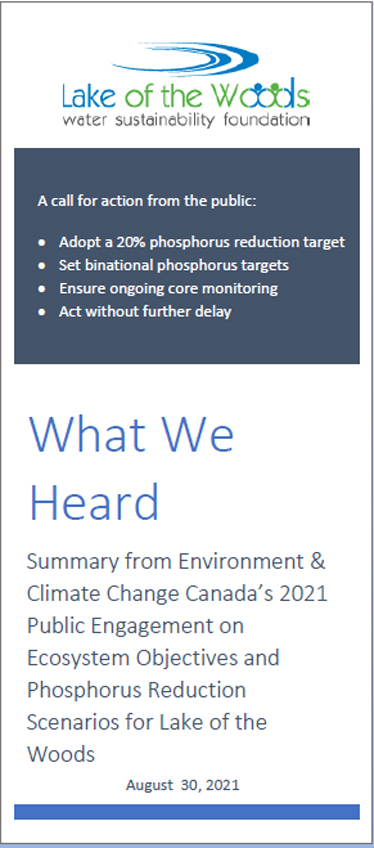 LOWWSF has released a report summarizing what we heard from the public during engagement sessions with Environment and Climate Change Canada on its set of proposed lake ecosystem objectives and potential phosphorus reduction scenarios to improve water quality for Lake of the Woods. Hundreds participated in ten webinars and online via ECCC's Lake of the Woods engagement website. The messages were clear and a call to action -- "get on with it":
LOWWSF has released a report summarizing what we heard from the public during engagement sessions with Environment and Climate Change Canada on its set of proposed lake ecosystem objectives and potential phosphorus reduction scenarios to improve water quality for Lake of the Woods. Hundreds participated in ten webinars and online via ECCC's Lake of the Woods engagement website. The messages were clear and a call to action -- "get on with it":
- Adopt a 20% phosphorus reduction target
- Set binational phosphorus targets
- Ensure ongoing core monitoring
- Act without further delay
pdf Download the report here(551 KB)
During winter and spring 2020-2021, Environment and Climate Change Canada (ECCC) participated in an engagement process to solicit public input and discussions on a set of proposed lake ecosystem objectives and phosphorus reduction scenarios to inform its next steps to improve water quality of Lake of the Woods.
During these sessions, ECCC presented results of its science and watershed-lake modeling and outlined expected responses of the lake to three potential scenarios for overall phosphorus reduction to Lake of the Woods (5%, 20%, and 30%). ECCC also proposed three potential Ecosystem Objectives and related Response Indicators focused on maintaining appropriate levels of primary productivity in various regions of the lake, minimizing harmful or nuisance algal conditions, and minimizing low dissolved oxygen conditions in the shallow, southern basin of Lake of the Woods.
During these engagements, the main points that we heard from participants were:
- Consensus on the 20% phosphorus reduction scenario as it met most objectives, was aligned with Minnesota’s target (17.3%), and was considered achievable.
- Binational targets should be set; achieving them is a shared responsibility of all levels of government, individuals, and industry in both countries.
- There is a strong desire to “get on with it” and take steps to reduce phosphorus loads based on best available knowledge and without further delay.
- Needed is a collaborative approach – Some asserted strongly that targets, monitoring, and reporting on progress should be coordinated by the IJC.
- Adaptive management is supported – called for was a commitment from governments to a systematic and sustained monitoring program to support adaptive management.
- Scenarios were too high-level and lacking information from a management standpoint that could inform actions. Desired are details of where the Canadian sources of phosphorus are, how much they should be reduced (source targets), and where or if there are any practical actions that can be taken.
- Perception that federal and provincial governments in Canada are lagging behind the U.S. on this issue and that Minnesota’s study is further along to the level of identifying sources and assigning specific targets and starting actions.
- Consensus that there is enough information to act without further delay to reduce phosphorus pollution.
